Article by Chas S. Clifton
Local Lore – November 2003 – Colorado Central Magazine
LAST SPRING, a check came for me from Leland Feitz, owner of Little London Press in Colorado Springs. “Little London” was an 1890s nickname for Colorado Springs, coined when the city was flush with British mining capital and had its own stock exchange. Feitz publishes short books on local history, and in 1982, he turned a newspaper feature series that I had written into Ghost Tales of Cripple Creek.
Feitz claimed his books functioned for his authors in the way that insurance policies function for insurance salesmen: you don’t get a lot of money when the book is published, but you get steady payments for years thereafter.
This time his letter said that he had reprinted 750 copies of Ghost Tales, retail price $3.95 (up only a dollar in twenty years), and my 10% of his net profit (in advance, Leland’s way of simplifying bookkeeping) was $133. “Check enclosed. Hope all is well with you and Mary.”
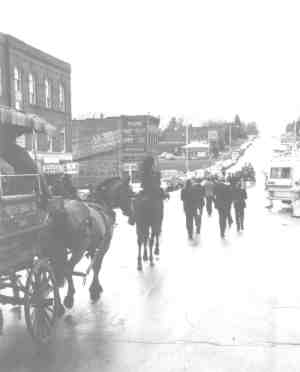
That’s a smaller press run than in years past and, consequently, a smaller check. But thousands of copies of Ghost Tales of Cripple Creek, a book designed to sell best in the two little towns of Cripple Creek and Victor, have gone home with tourists over the years.
Eagle Rock, 2003
A few days later, Mary and I are climbing a steep, grassy ravine on the southeast face of Eagle Rock, a granite monolith surrounded by pine-clad slopes. It’s May and mostly cloudy. The wind is brisk from the Mosquito Range to the west. Lightning-charred fragments — trunks and branches of limber pines — are scattered on the hillside. Angus cattle graze in a pasture below, but the land, while clear of snow, does not yet feel fully awakened into spring. Bursts of butterflies swirl up the ravine like smoke on the wind.
To catch my breath, I stop, take out Dad’s little point-and-shoot camera, and call down to Mary, “Stop, and let me take your picture.” She is wearing a black sweater and olive green cargo paints. She looks uphill at me, the straps on her daypack tight on her shoulders, wind lifting her hair. Click-whirr.
Cripple Creek, 1981
When the check came, Mary remembered our season of ghost hunting in Cripple Creek’s Victorian commercial district. We sat up late one night in the ruined top-floor ballroom of the Fairley Bros. & Lampman Block, a brick commercial building (now a casino) on Cripple Creek’s main street, Bennett Avenue. The building was mainly empty then except for a ground-floor restaurant; and its two upper floors were the haunt of “Maggie,” described by building owner Katherine Hartz, who had seen her, as a “Gibson Girl” sort of a ghost in 1900 garb of white shirtwaist, ankle-length dark skirt, and high-buttoned boots; a young brunette with her hair pinned up in the style of the day.
“Everyone calls her Meg, Maggie, Margaret — some form of Margaret. It’s almost automatic, before they realize what they’re doing,” Hartz told me.
We didn’t sense Maggie or any other purported ghosts in the building — didn’t smell her perfume, didn’t hear the clackety-clack of her manual typewriter in one of the old offices on the second floor — although we sat in the darkness of those deserted rooms for a long time and slept that night in one of the old offices that had been turned into a spartan apartment.
Cripple Creek, 1977
In 1977 a Cripple Creek resident, Myke Minow, decided to re-create the funeral of Pearl DeVere, madam of the Old Homestead brothel (now a museum), who committed suicide by morphine overdose in 1897. The planning committee, which included a number of the town’s summer workers — waitresses, bartenders, and actors from the Imperial Hotel melodrama cast — had worked things out over lunches at the Palace Hotel (now a casino, like the Imperial). Mystical approval came from the astrologer Linda Goodman, who owned two houses in Cripple Creek, where she laid a place at the dining table for the lover who deserted her years before and created shrines to a daughter mysteriously murdered in New York City.
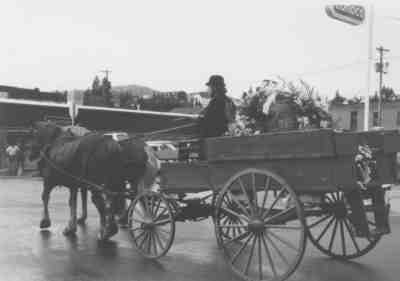
Local historians say that Pearl DeVere’s respectable sister arrived on a train from back East, only to leave again when she discovered her sibling had been a prostitute.
In response, the Cripple Creek Times editorialized: “Cripple Creek can bury its own dead.”
An anonymous donation of $1,000 arrived in a letter, postmarked Denver, directing that Pearl be buried in an elegant dress, so her friends had no need to follow their first plan of auctioning the expensive Parisian gown she had died in. A crowd of gold miners turned out for the funeral, and the Elks Band led the procession up Bennett Avenue, followed by a hearse holding a lavender casket covered by red and white roses.
Behind the hearse, a man walked holding the bridle of a horse that pulled Pearl’s elegant phæton carriage, its single seat occupied by a large cross made of pink carnations. Behind the phæton, other buggies carried the women of Myers Avenue, “the row,” heavily veiled in mourning.
Shrugging off local moralists’ objections to glorifying a prostitute, Mrs. Minow hoped that the Pearl DeVere Affair would become an annual summer event, another draw for tourists. She wrote a musical to be performed at the Palace Hotel, organized a eulogy contest at the Imperial, and, without too much difficulty, recruited prostitute-reenactors and other participants to re-create the 1890s funeral procession through town to the Mount Pisgah cemetery — where the human casualties of the mining boom lie, many of them organized by fraternal order: the Elks here, the Woodmen of the World there.
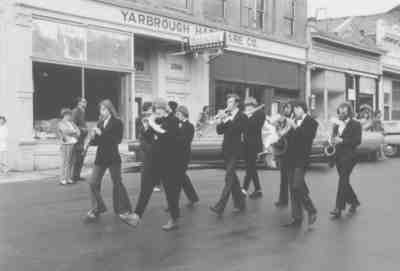
THE 1977 PROCESSION started at the former Fairly Bros. & Lampman’s Undertaking Parlors, the mortuary where Pearl DeVere had been prepared for burial. Lacking a hearse, the imitation casket rode in a simple wagon pulled by two horses, driven by a bearded young man in frock coat and derby hat. (No black crepe, nor black plumes on the horses’ harness.)
Another carriage carried the “girls” with their beads, lace, veils, and parasols. A scratched-together marching band of five or six musicians oompah’d up the street; the players’ costumes and the prostitutes’ attire were likely loaned from the costume room of the Imperial Players. Shooting photos for a magazine article, I paralleled the procession for a block, past the oddly silent tourists and the “outlaw” bikers and the summer residents of the town.
Things got a little blurry for a few moments. Was there another, larger band mingling with the musicians, while lodge members in fezzes and plumed helmets marched behind? The little procession clattered and tootled past the courthouse and the last town buildings, climbing towards the cemetery gate under a softly falling drizzle.
There Myke Minow gave her own elegy, explaining that they honored Pearl rather than mocked her. And then she herself died not long afterwards, and the Pearl DeVere Affair remained a one-time event. But if a debt was paid, it needs to be paid only once. The respectable women who lead the tours of the Old Homestead brothel museum say that they are never troubled by ghosts.
Eagle Rock, 2003
We reach the narrow ridge connecting the tallest granite outcropping of Eagle Rock with a second, lower summit. A raven, not an eagle, sails from the higher rock, catches the west wind, and flares off to the east. We drop our packs, stretch, and gaze towards the higher snowy peaks to the west. To the east, the slope falls away steeply. Somewhere down there is a low cairn covering the grave of Fritz, the dog of my childhood, who died about the time I started my first year away at college. Fritz was a 15-pound dachshund, but in his own mind he weighed about 90 pounds. He chased rabbits exuberantly if hopelessly, on occasion pursued deer, and once nearly died after taking on two larger dogs simultaneously. He went everywhere that the family went, and on weekdays he often rode with Dad in his Forest Service pickup.
A few weeks before I left for college, Dad and I were camping on Texas Creek above Gunnison. During the night Fritz fell ill. Dad held him in his lap, sitting cross-legged on his sleeping bag, sobbing from helplessness. The next morning we packed quickly, and drove him to Dad’s vet in Colorado Springs. Medicated, Fritz lived a little while longer, but never fully recovered. Dad drove him to Eagle Rock and buried him at its base, showing me the grave when I came home the next summer.
“I went up to Fritz’s grave,” he wrote to me in a later letter. “There were rabbit tracks right by it in the snow. He must be up there chasing rabbits.”
In 1984, the summer before I went to graduate school, I was drawn to take Mary camping on Texas Creek again.
Ghost hunters, 2003
None of my Cripple Creek photos showed any ghostly presences. I count only six musicians in the photo of the Pearl DeVere Affair funeral procession.
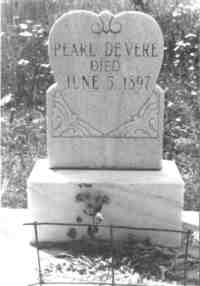
Researching something else on the Web, I recently came across www.ghostweb.com, site of the International Ghost Hunters Society. It appears to be the creation of a middle-aged couple — pictured standing in a cemetery — and its logo is a motor home against Monument Valley-style sandstone spires, a virtual icon of the recreational-vehicle lifestyle. The society offers home-study courses towards becoming a “certified ghost hunter.” Perhaps Mary and I would have done better if we had had credentials.
The International Ghost Hunters Society web site boasts “almost 9,000 real ghost photos!” and a virtual archive of “ectoplasm,” the intangible substance that ghost-hunters claim to see and photograph. I wonder if the gradual shift from “wet” to “dry” photography, from film to digital images, will increase or decrease the number of photographs whose out-of-place lights, shadows, and other forms are put forth by ghost hunters as evidence of spirit presences. Would such spirits have an easier time with electrons than silver-based emulsions?
Florence, 2003
On May 14, 2003 Mary and I stop in Florence for breakfast at The Pour House coffee shop, getting caffeinated for the 100-mile drive north on windy roads to Eagle Rock. Reading The Denver Post, I see a short item in the Lifestyle section, seeking readers’ best nuggets of fatherly advice, which an editor will compile for Father’s Day. Later, driving the long ascent of Currant Creek Pass on Colorado 9, I try to recollect some.
Dog-training: “Give your dog a short name so you can call him.”
Squirrel-hunting: “Don’t look for squirrels, look at the whole tree.”
Fishing small mountain streams for trout: “Stay low. You got to ‘Indian up’ on them.”
I do better with my father’s characteristic sayings. On camping trips, sunburnt, stubble-faced, frying a steak over the campfire and asking rhetorically, “Say, boy, I wonder what the poor people are doin’ tonight.”
Or “Dogs have by nature qualities that people struggle to attain.”
But advice? He might have offered more, but I was usually too proud to take it. Last December, he told me, “You were always pretty independent — you didn’t ask for much help.” I wanted to reply that if he meant money, as he seemed to, that I was afraid I would lose his respect if I asked for money once I was out of college and on my own. But the words stuck in my throat. I was mute, as usual. Would the Denver Post Lifestyle editor be interested in squirrel hunting or dog training?
Sun City, Arizona, 1995
My parents divorced when I was 14, and each remarried not long afterwards. Herb Benson, my stepfather, whom I never got to know well, died in 1991 after a long illness. My mother followed him in 1995 after a sudden infection of viral meningitis. I spent the last four days of her life at her bedside and the nights in her home in Sun City, Arizona. Even though I knew she was dying, I still expected her to walk through the door and catch me doing something that I shouldn’t.
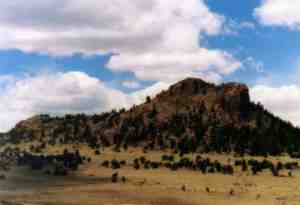
After the will was probated, I made an appointment with a real estate agent who dealt with Sun City properties. He and I perched on the kitchen counters of her empty condominium, filling out all the forms needed to list it for sale. Checking off a list of disclosure questions about the property, I came to this one: Was the property haunted, yes or no? I laughed and asked the agent how I was supposed to know if the condo was haunted or not. He explained that the state required that that question be included along with the more mundane questions about water supply, plumbing, heating systems, and so on, because someone in the past had won a lawsuit against a seller who, the plaintiff alleged, had sold the plaintiff a haunted house without disclosing that crucial fact. I checked the “no” box.
I did not think that my mother was hanging around. Not too many days after her death, I had a vivid dream. I was sitting in the back seat of a car, while my mother, looking young and beautiful, drove westward on a city street, laughing and talking with another woman of about her age. They paid me no attention; I was merely an observer. I awoke pretty certain that she had passed on to another stage in the afterlife. The condominium was on the market for only four days before we had an offer at the asking price.
Cripple Creek, 1991
In 1991, Mary and I revisited Cripple Creek. Hammers were banging all up and down Bennett Avenue. The voters of Colorado had voted to allow limited casino gambling in three mountain towns, all former mining boom towns that had been limping along on a summer tourist-based economy for decades: Central City, Black Hawk, and Cripple Creek. (Cripple Creek and its smaller neighbor Victor, which was actually home to the richest mines, had enjoyed a gold-mining boomlet around 1980.) Now every gift shop, ice cream parlor, and antiques store was being turned into a casino, everything new behind the original 1890s facades. New ones would be built as well. One would be named for Johnny Nolon, the casino owner who a century before had stepped forward to organize the real Pearl DeVere’s funeral.
Cripple Creek’s sedate spirit inhabitants must have been in for a shock. The booming gold camp of the 1890s, with its three rail lines and streetcar system, its busy mines, had been replaced during the mid-twentieth century by a sleepy “ghost town” that awoke only to serve its tourists in the summer. Now that touristy Cripple Creek, which had once hosted the Pearl DeVere affair, was vanishing in turn under acres of eye-dazzling carpeting and forests of slot machines.
Mining continued as well: a huge open pit gold mine gapes wide between Cripple Creek and Victor, swallowing many of the picturesque old structures. Attendance at the museum has fallen off, says Leland Feitz, its former director. Now the gamblers — many of them retirees bussed in from Pueblo and Colorado Springs — arrive and go straight into the casinos.
Rapid City, South Dakota, 1999
In the fall of 1999, Dad decides to revisit the Black Hills of South Dakota, where he had worked as a Forest Service district ranger in the late 1940s and again from 1953-1961. Catharine, my stepmother, is concerned about his making the trip alone at age 83, but she is content after I agree to come along and share the driving. Before dawn on a Friday morning, he is piloting his Lincoln Continental through quiet streets in Colorado Springs; we eat a late breakfast in Cheyenne, Wyoming, and by early afternoon we are in Custer, South Dakota, visiting another Forest Service retiree. We make a circuit of old friends and old sites; I keep my ears open, and bits of family history start falling into place, mostly about that gap that opened between my father and mother in those years.
After the second or third time I hear my father tell one of these old men, “This is probably the last time that I will see you,” I have to turn away and clench my jaws.
On Saturday, we stop at the Rapid City Ranger Station. He visits with Bill McBride, his old crew boss from the 1950s, and with a Forest Service staffer who happens to be in her office that weekend. I walk the grounds. The three-bedroom 1940s-style frame house with its matching office-garage that stood there when I was a boy are gone, replaced by a new, much expanded administrative building and a vehicle yard enclosed by chain-link fence. The trees in the north-side shelter belt are still mostly alive, as are some of the trees we planted around the residence. From them, I work out the sight lines from my former home. When I tell my older sister that the house is gone, she is outraged. She recalls all of the girlhood hours she spent polishing woodwork and buffing floors like a Victorian housemaid under our mother’s direction. But the Forest Service is not in the business of preserving family history. As an agency, it does a poor enough job with its own institutional memory, let alone the Clifton family’s.
Sunday morning I am driving the big Lincoln south on South Dakota 79 towards Hermosa. Dad looks west towards the hills and softly says, “Goodbye, Black Hills.” I clench my teeth, looking straight down the highway.
Eagle Rock, 2003
On the summit ridge of Eagle Rock, the swirl of butterflies that blew up the steep ravine is gone. A different butterfly does figure-eights around us, a Mourning Cloak, which was apparently named to describe its purplish-black wings with their narrow pale band. But does this delicate creature deserve such a grim, Victorian name?
There would have been little visible mourning on “the row” after Pearl DeVere’s first funeral; the business of prostitution demands the appearance of excitement, not mourning cloaks.
I could not write a book on grief. All I have to say is that you cannot fake it and you cannot rush it. Grief sets its own schedule, so you might as well go back to work, where there are undoubtedly things that need to be done — even if you can’t always do them as well as you might.
Today, we no longer have the Victorian conventions of “full mourning” dress, and “partial mourning,” so you just have to tell the people around you what is going on, why you missed the meeting or whatever. But after a while, it seems like you are always talking about yourself.
Otis Clifton, my father, died in early January 2003, followed by his wife Catharine two weeks later.
In the dream, I am driving a big car, like the Lincoln. Dad sits in the back seat, gabbing with another old man, one of the Hillemans from the German side of his family. They are having a good time. I awake sorrowful but satisfied.
On Eagle Rock, Mary and I open our packs on one of the granite boulders: two small but hefty cardboard boxes, two plastic champagne flutes, and a half bottle of champagne.
“We have had good lives,” they said, “We have done what we wanted to do.” And so they did what they wanted to do.
I let the cork fly; the higher altitude gives it a little extra boost and it sails into space. I think I hear Catharine saying cheerily, “Happy New Year!” Some of the ashes have landed on a rock ledge under the wind-shaped limbs of a limber pine tree. The west wind lifts them into a brief ectoplasmic swirl, and then they are gone.
Chas Clifton lives in Wetmore and teaches English at Colorado State University, Pueblo.

